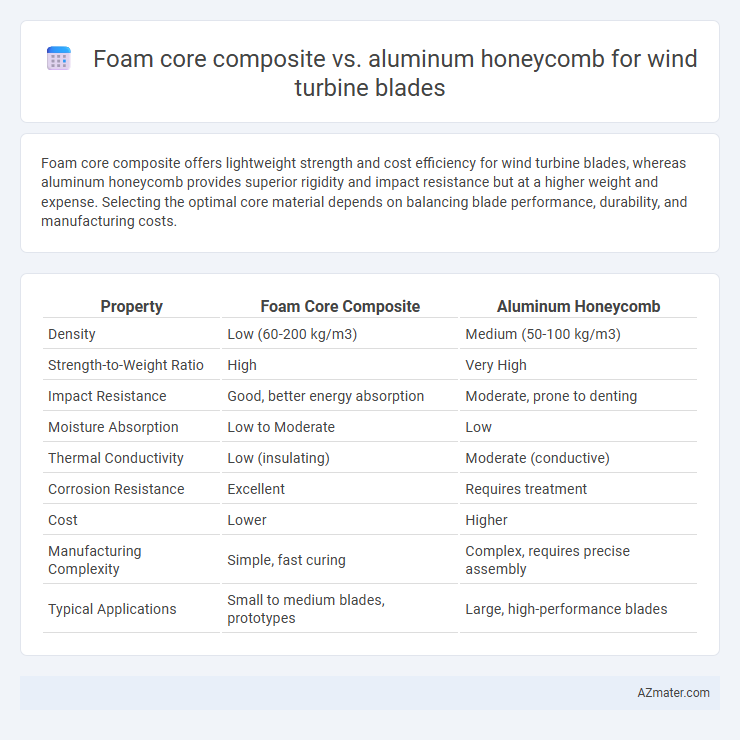Foam core composite offers lightweight strength and cost efficiency for wind turbine blades, whereas aluminum honeycomb provides superior rigidity and impact resistance but at a higher weight and expense. Selecting the optimal core material depends on balancing blade performance, durability, and manufacturing costs.
Table of Comparison
| Property | Foam Core Composite | Aluminum Honeycomb |
|---|---|---|
| Density | Low (60-200 kg/m3) | Medium (50-100 kg/m3) |
| Strength-to-Weight Ratio | High | Very High |
| Impact Resistance | Good, better energy absorption | Moderate, prone to denting |
| Moisture Absorption | Low to Moderate | Low |
| Thermal Conductivity | Low (insulating) | Moderate (conductive) |
| Corrosion Resistance | Excellent | Requires treatment |
| Cost | Lower | Higher |
| Manufacturing Complexity | Simple, fast curing | Complex, requires precise assembly |
| Typical Applications | Small to medium blades, prototypes | Large, high-performance blades |
Introduction: Key Materials in Wind Turbine Blade Construction
Foam core composites and aluminum honeycomb are critical materials in wind turbine blade construction, offering distinct structural and weight advantages. Foam core composites provide excellent stiffness-to-weight ratios and enhanced fatigue resistance, essential for blade durability under cyclic loading. Aluminum honeycomb structures deliver superior compressive strength and impact resistance, making them ideal for load-bearing sections and improving overall blade performance and longevity.
What is Foam Core Composite?
Foam core composite is a lightweight structural material used in wind turbine blades, consisting of a foam core sandwiched between composite fiber layers such as fiberglass or carbon fiber. It provides excellent strength-to-weight ratio, high stiffness, and good fatigue resistance, making it ideal for improving blade performance and longevity. Compared to aluminum honeycomb, foam core composites offer better corrosion resistance and easier fabrication, reducing maintenance costs in wind turbine applications.
What is Aluminum Honeycomb Structure?
Aluminum honeycomb structure is a lightweight, high-strength core material composed of hexagonal cells formed from aluminum strips, providing exceptional stiffness and energy absorption. It is widely used in wind turbine blades to enhance structural integrity while minimizing weight, resulting in improved aerodynamic performance and durability. Compared to foam core composites, aluminum honeycomb offers superior compressive strength and fatigue resistance, making it ideal for large-scale turbine blade applications.
Weight Comparison: Foam Core vs Aluminum Honeycomb
Foam core composites generally offer a significantly lower weight compared to aluminum honeycomb structures, making them advantageous for wind turbine blades where reducing mass is critical for improved efficiency and ease of installation. Aluminum honeycomb, while stronger and more rigid, tends to add considerable weight due to its metal composition, which can increase the overall blade load and decrease turbine responsiveness. The density of foam core typically ranges between 0.03 to 0.06 g/cm3, whereas aluminum honeycomb density is around 0.1 to 0.3 g/cm3, indicating a substantial weight saving when using foam core materials.
Structural Strength and Stiffness Analysis
Foam core composite and aluminum honeycomb materials exhibit distinct differences in structural strength and stiffness for wind turbine blade applications. Aluminum honeycomb offers superior stiffness-to-weight ratio and enhanced compressive strength, improving blade rigidity and resistance to deformation under high aerodynamic loads. Foam core composites provide greater impact resistance and fatigue durability, contributing to prolonged blade lifespan but with comparatively lower stiffness than aluminum honeycomb cores.
Fatigue Resistance and Durability
Foam core composites exhibit excellent fatigue resistance due to their energy absorption capabilities and ability to dampen vibrations, making them highly durable under cyclic loading typical in wind turbine blades. Aluminum honeycomb cores offer superior stiffness-to-weight ratios but can suffer from fatigue-induced crack propagation and corrosion, potentially reducing long-term durability. Advanced foam cores tailored with enhanced resin systems provide improved longevity in harsh operational environments compared to aluminum honeycomb structures.
Manufacturing Process and Scalability
Foam core composites offer a simplified manufacturing process with faster curing times and easier handling, making them suitable for small to medium production runs of wind turbine blades. Aluminum honeycomb cores require a more complex fabrication involving precise bonding and curing under controlled conditions, which can increase production time but enhance structural performance. Scalability favors foam cores for rapid prototyping and medium-scale manufacturing, while aluminum honeycomb supports large-scale production with consistent quality and superior strength-to-weight ratios.
Cost Considerations in Blade Production
Foam core composites offer lower material costs and simpler manufacturing processes compared to aluminum honeycomb, making them more cost-effective for large-scale wind turbine blade production. Aluminum honeycomb cores provide superior strength-to-weight ratios but involve higher raw material prices and more complex fabrication, increasing overall blade production expenses. Balancing cost and performance, foam core composites are often preferred in budget-sensitive projects, while aluminum honeycomb is chosen for high-performance blades where durability justifies the expense.
Environmental Impact and Sustainability
Foam core composites in wind turbine blades offer lower embodied energy and easier recyclability compared to aluminum honeycomb, resulting in reduced environmental impact during manufacturing and end-of-life disposal. Aluminum honeycomb cores, while providing superior strength-to-weight ratios, require energy-intensive mining and smelting processes, contributing to higher carbon emissions and less sustainable resource extraction. Choosing foam core composites supports improved sustainability by minimizing ecological footprint without significantly compromising blade performance.
Conclusion: Choosing the Optimal Core Material for Wind Turbines
Foam core composite offers lightweight properties and good fatigue resistance, making it suitable for cost-effective wind turbine blades with moderate load requirements. Aluminum honeycomb provides superior stiffness-to-weight ratio and excellent compressive strength, ideal for large-scale turbines demanding high structural integrity and durability. Selecting the optimal core material depends on balancing blade size, performance needs, environmental conditions, and budget constraints to maximize turbine efficiency and lifespan.

Infographic: Foam core composite vs Aluminum honeycomb for Wind turbine blade
 azmater.com
azmater.com